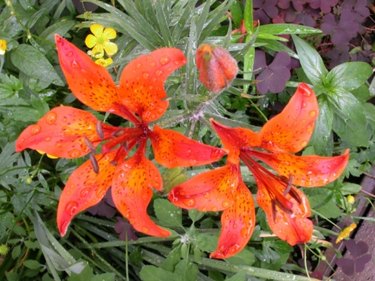Things You'll Need
Pruning shears
Vase
Mulch (shredded leaves or wood chips)
Fertilizer (10-10-10)
Hand rake

Garden lilies provide a tall and majestic presence in a flowerbed, with their splashy blossoms in vivid colors. Because the lily stems are so tall, they are at risk for breakage, both from wind and from other accidental harm. If lily stems become broken, you may be able to salvage the tuber beneath the soil so that it receives enough nutrients to put forth new blooms during the following growing season.
Step 1
Cut off the stem at the point of breakage with the pruning shears. Bring the stems with any blossoms into the house after stems break off. Place them into a vase of water and you may be able to enjoy the blossoms in the vase. Even blossoms that have not fully opened often open in a vase of water.
Video of the Day
Step 2
Apply up to 4 inches of mulch around the base of the remaining stem to keep the soil moist and prevent weed growth around the lily plant.
Step 3
Water the lily plant only if dry conditions develop. As long as 1 inch of rainfall occurs each week, the lily tuber should receive enough irrigation.
Step 4
Fertilize the lily stem and tuber that remains outside by sprinkling about 1/4 cup of granular fertilizer over the soil approximately halfway through the growing season. Scratch the fertilizer into the soil with a hand rake and water the soil thoroughly to saturate it.
Step 5
Cut what remains of the stem off to just above the soil level when it turns yellow in the autumn. Make a clean cut with the pruning shears. Discard the stem without composting it to prevent adding potential diseases to your compost bin.
Step 6
Look for new growth the following growing season. The tuber beneath the soil may get enough nutrients for future growth with as little as half the stem remaining on the plant. You won't know if enough stem remained to nourish the plant until the plant begins growing again after the winter.
Video of the Day